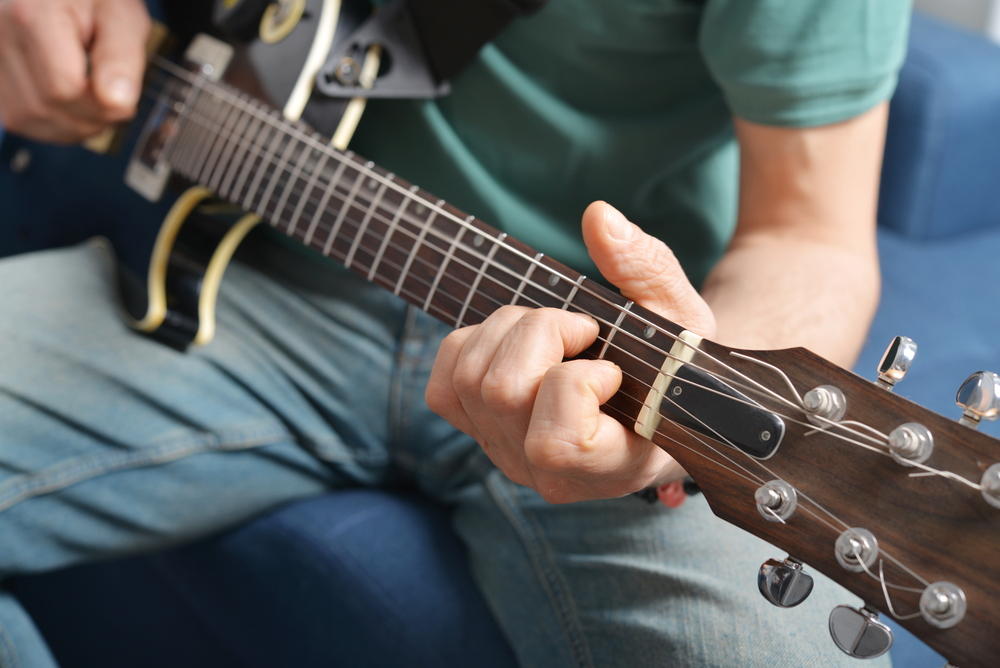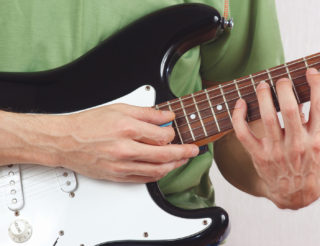Here’s Everything To Know About The Dm7 Guitar Chord
Author: Matthew King

In this article, we’re going to explore another crucial minor 7th chord, the Dm7 guitar chord! This one is seen quite a bit because it works great as an open chord and because it’s in a very popular musical key, C major. In this article, we hope to illustrate many of the wonderful uses of this versatile chord and help you see how it appears in many songs you already know.
A question that comes up a lot for anyone new to this chord is, “how is Dm different from Dm7?”
The answer is quite simple! The m7 means that you need to add a minor 7th interval to the minor chord in question (Dm). When I was first learning this chord, I noticed that nearly every shape of this chord would have a note in the chord diagram that was one full step down from the root. Let’s look at the common chord shapes of Dm7 to see this in action:
Every one of these shapes has a note played that’s behind the root note, which in this case is the note C. If you already know the minor chords, you only have to adjust the shape with this one piece of knowledge to play the Dm7 guitar chord. So remember this when we explore some songs in the next section!
Table of Contents
Songs That Use The Dm7 Chord
Take note that the barre chord version of Dm7 will be the most popularly used, followed by the version of the chord that starts on the D string. We’ll discuss later in this article why it’s not in the chords key of d guitar instead.
Our first example from a real song is “Just The Way You Are” by Bruno Mars. The song is only 4 chords but maybe a little challenging if you’re not used to barre chords, or the minor 7th chord fingering, quite yet.
(F – F – Dm7 – Dm7 – Bb – Bb – F – F)
We suggest that you keep your first finger on or around the first fret the entire time, as it will be needed to barre every chord in this song.
Here’s another song, also in F major, that uses all the same chords except for one. Here’s Adele’s “Easy On Me:”
(F – Dm7 – F/A – Bb)
A big problem with strumming chords like this is that you’ll only kinda sound like the original recording. In this song, it’s played on a piano and the notes of each chord are arranged differently. Chord shapes are a big help to play songs like this, but it’s good to be aware of this typical problem of playing pieces not written for guitar.
On that note, here is a song that was definitely written for the guitar, The Beatles “Can’t Buy Me Love:”
(Em – Am – Em – Am – Dm7 – G)
This is a song you can easily match the chords to the original song with, and it’s not quite as challenging with all the barre chords.
Another great guitar song that used the Dm7 guitar chord is Eric Clapton, or Derek & The Dominoes, “Layla”
((D5 – Bb5) – (C5 – D5))
Notice that it doesn’t use the Dm7 guitar chord, but the key it’s in (D minor), and the chords used after implying the sound of the key and the chord could be easily substituted for the D5.
The last song we’ll show you that uses the Dm7 guitar chord, or a close version of it, is Guns n’ Rose’s “Don’t Cry.” This song just uses the Dm chord, but since it’s in A minor, you can also use the Dm7 chord if you want a more nuanced way to play this progression. Also take note that this is just the chords and not the tab. Any tab you find online should show you how the notes of these chords are played:
(Am – Dm – G – C – G/B)
An article that will help you understand how all of these songs work together is this one on the key of b flat guitar.
Other Ways To Play The Dm7 Chord
One concept we haven’t touched upon in any of our articles regarding chords like the Dm7 guitar chord……is that you don’t have to play just this version of it. The beauty of music theory is that it allows you to see many other ways to play this chord other than just a chord shape. As long as you know how it works, and what notes are in it, you can get very creative with your choice of chords to use for a song.
Take a moment compare the X57565 Dm7 guitar chord versus the following chords:
Although each is a different set of notes, and belongs in different musical contexts, the composition of the chords varies quite a little. Dm9 will add just the E note, and keep the rest. Dm7b5 only changes the A note to Ab/G#. Dm7/F has F in the bass instead of D. Finally Dmmaj7, changes the C note to C#, and keeps the rest of the chord intact.
This may be more advanced for some of you, and probably all you want is a few shapes of the Dm7 guitar chord. However I’m trying to reveal an important truth to you…..there are lots of ways to play chords, and thus songs than with just a standard chord shape.
Scales To Use To Play The Dm7 Sound
In my articles, I like to give the fellow lead guitarists out there some info on how to play over such chord progressions as the one above. This way you’ll be ready and able to play something amazing over the Dm7 guitar chord in almost every situation!
So first, let’s look at D natural minor. This scale is best used when you’re playing a progression that’s in D minor already, or in the relative major key of F major. The chord progressions of “Just The Way You Are” and “Easy On Me” are such chord progressions:
D natural minor = D – E – F – G – A – Bb – C
F major scale = F – G – A – Bb – C – D – E
Dm7 = D – F – A – C
F Major = F – A – C
Bb = Bb – D – F
C = C – E – G
The Dorian mode is another scale that works well over the Dm7 chord, but using it implies a different set of chords than what’s available in the key of Dm:
D Dorian = D – E – F – G – A – B (maj6) – C
C Major = C – D – E – F – G – A – B
Am = A – C – E
G = G – B – D
C = C – E – G
Dm7 = D – F – A – C
This is what’s often left out in most discussions of modes and scales. A scale implies all of these notes because of its construction. Simply changing the Bb to B gives you the dorian mode!
For the last scale, let’s look at one that’s more exotic…..the D melodic minor scale:
D melodic minor = D – E – F – G – A – B – C# (maj7)
Dmmaj7 = D – F – A – C#
A7 = A – C# – E – G
G7 = G – B – D – F
Faug = F – A – C#
Caug = C# – F – A
Again, just one two-note change from the minor scale (Bb to B and C to C#) gives us a whole new set of chords to imply and play over!
We realize this is a lot to take in, and that you may not understand our fascination behind it yet. What we’re trying to show is just how many musical sounds are available (like tritones!) to you once you can look past the basic chord shapes and scale patterns. That’s why we made the Uberchord App! It helps you practice seeing all of these possibilities, and helps you retain this new knowledge.
Download it now, and use this knowledge to create your own melodies and chord progressions using the Dm7 guitar chord.








No comments yet - be the first.